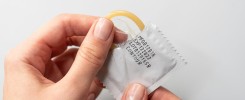How Effective Arondoms at Preventing Pregnancy?
Used perfectly with every single act of intercourse, condoms are about 98% effective at preventing pregnancy. However, in reality, actual use pregnancy rates are around 85% due to occasional errors in usage. Condoms can break or slip off if stored improperly, used past expiration date, applied incorrectly, or subject to friction or damage during sex.
Still, with consistent and proper use, condoms remain one of the most reliable contraceptive options available. The chances of outright condom failure are quite low if you take measures to use them correctly each time. Education about handling, application, removal, and disposal is key to getting the full contraceptive benefits of condoms.
Enhancing Effectiveness by Combining Condom Use with Other Methods
For those who absolutely want to minimize pregnancy risks, combining condom use with an additional contraceptive method is highly advisable. Methods such as the pill, implant, hormonal IUD, injectables, etc, can provide an extra layer of protection on top of condom use.
Each contraceptive has its own failure rate, so using a condom along with another option greatly reduces the chances of both failing at the same time. As long as you are diligently using both methods as recommended, your chances of getting pregnant accidentally are extremely low.
Do You Need a Condom During Infertile Days of Menstrual Cycle?
You may have heard pregnancy is unlikely during menstruation or for a few days after mensuration when ovulation has not occurred. However, no days are 100% “safe” for condomless sex if you want to avoid pregnancy.
Sperm can survive in the female reproductive tract for up to 5 days. If you have intercourse at any point during the menstrual cycle, sperm could remain viable by the time ovulation occurs. The only completely certain way to prevent conception is abstinence. For sexually active couples, condoms remain an essential contraceptive tool during every act of vaginal intercourse, regardless of menstrual timing.
Proper Storage and Handling of Condoms
In order to get maximum effectiveness from condoms, you must take measures to protect them from damage during storage and handling:
- Avoid keeping condoms in hot places like wallets, pockets, or cars for extended periods. The heat and friction can cause damage over time. Store in a cool, dry place like a bedside drawer.
- Before having intercourse, closely inspect the packaging for any tears or holes that could compromise the condom inside. Never use a damaged condom.
- Check the expiration date and do not use expired condoms, which break more easily due to material degradation.
- Carefully open the package, take care not to tear condom with nails or jewelry. Do not use teeth to open.
- Examine the condom itself for any defects before placing it on the erect penis.
Correct Condom Application Techniques
In addition to proper storage and inspection, taking steps to apply condoms properly greatly reduces the chances of slippage or breakage:
- Leave a half-inch space at the tip to collect semen. This prevents breakage.
- Unroll the condom all the way down to the base of the erect penis, eliminating air bubbles.
- Apply water-based lubricant, either inside condom tip or on the outside to increase comfort and decrease friction.
- For internal condoms, insert into vagina carefully and ensure the outer ring remains outside the vaginal opening.
- Hold the base of the condom firmly during intercourse to prevent slippage.
Safe Condom Removal and Disposal
It’s equally important to properly handle condom removal after ejaculation and dispose of used condoms safely:
- After intercourse, withdraw the penis while still erect, continuing to grip the condom base securely.
- Carefully roll off the condom to avoid spilling any semen.
- Tie a knot at the open end before wrapping the used condom in a tissue and disposing in the trash can. Never flush condoms.
- Never reuse condoms. Always use a new one each time you have sex.
Lubricant Recommendations for Condom Use
While most condoms come pre-lubricated, the use of additional water-based lubricants is highly recommended to reduce friction and prevent condom breaks. Oil-based lubricants like petroleum jelly or body lotions can damage latex condoms and increase the chances of them slipping off or tearing. However, polyurethane condoms are safe to use with oil-based lubes if needed.
Spermicidal condoms also are not recommended as the spermicide chemicals do not protect against STIs and may irritate delicate genital tissues.
Factors That Can Reduce Condom Effectiveness
While condoms are highly effective with proper use, there are some common mistakes that can compromise their contraceptive abilities:
- Using damaged, expired, or improperly stored condoms. Always inspect before use.
- Failure to leave space at the tip for semen collection. This can cause breaks.
- Not unrolling all the way down to penis base, leaving space for leakage.
- Using improper lubricants like oil-based products or spermicide.
- Not holding the base securely during sex allowing slippage.
- Delayed removal after ejaculation allowing spillage.
As long as you take measures to encourage proper condom use each time, such mistakes can be avoided. But occasional accidents may still occur. Having emergency contraception pills on hand is wise in case a condom break does happen despite best efforts.
Who Can Use Male Condoms?
The majority of people can safely use external male condoms with minimal health risks. However, those with severe latex allergies may need to opt for latex-free polyurethane condoms instead. People unable to maintain an erection sufficiently may also have trouble using condoms correctly.
For people with vulvas, internal condoms are also available and may be preferred by some. However, internal and external condoms should never be used together as the friction can cause tearing.
Benefits and Drawbacks of Using Condoms
Understanding the various advantages and disadvantages of relying on condoms as your contraceptive method can help determine if they are the right choice for your needs:
Potential Benefits:
- Highly effective barrier method when used properly
- Protect against both pregnancy and STIs
- Easily accessible and affordable
- Offer spontaneity for unplanned sex
- Non-hormonal option without systemic side effects
- No prescription required
- Variety of materials, textures, and sizes
Potential Drawbacks:
- Possibility of breakage or slippage with improper use
- Some people have latex sensitivity or allergy
- May interrupt sexual activity for some couples
- Require an erect penis to use correctly
- Do not offer prolonged protection against pregnancy as other methods may
As no single contraceptive method is perfect for every individual, being aware of the unique pros and cons of condoms allows you to make an informed decision.
Where to Access Condoms
Thanks to mainstream acceptance, condoms are widely available through multiple channels without age restrictions or prescriptions:
- Healthcare clinics – Family planning clinics, college health centers, STD clinics, and doctors’ offices frequently offer free condoms.
- Retail pharmacies – Condoms can be purchased affordably over-the-counter at drugstores, supermarkets, big box retailers. Online ordering is also available.
- Vending machines – Public restrooms may have vending machines dispensing condoms 24/7.
- Non-profit organizations – Some charitable and advocacy organizations provide free or low-cost condoms by mail or in-person.
When purchasing condoms in-person or online, always opt for a reputable brand and check labels for quality assurance and safety certifications. Also, confirm the products are not expired.
The Takeaway
Condoms certainly aren’t a perfect contraceptive method, but they remain one of the most effective options for preventing pregnancy and STIs during sexual activity when used consistently and correctly. Taking steps to encourage proper storage, application, usage, and removal reduces common user errors that can lower condom efficacy.
Combining condom use with an additional contraceptive provides maximum pregnancy protection. But even solitary condom use effectively shields against STIs. Discussing preferences, usage questions, and concerns openly with your healthcare provider allows you to determine if condoms are the right choice for your needs.
References
• “Condoms.” World Health Organization, Jul 20, 2023, https://www.who.int/news-room/fact-sheets/detail/condoms


